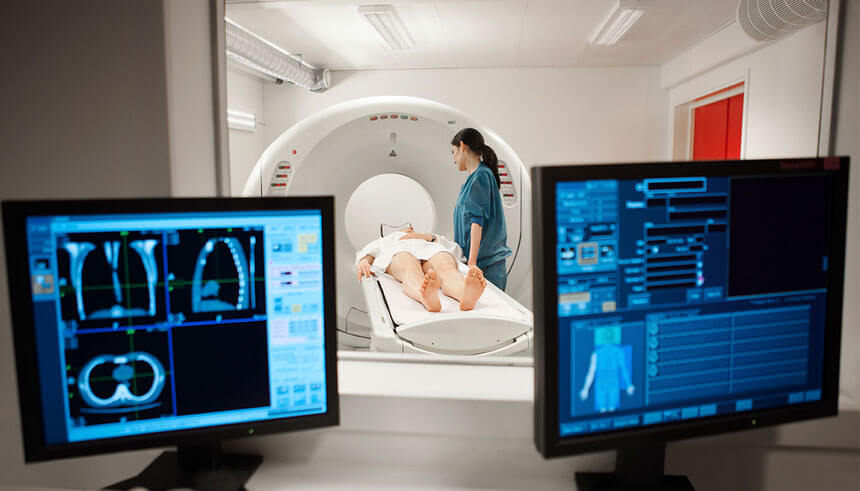U.S.-Asia Business
China's Medical Devices Market: A Must-Win Proposition
By Daniel Allen

Despite stiffening competition, regulatory hurdles and geopolitical ramifications, the growth potential of China's medtech space make it hugely compelling.
Today, China's medical devices market is developing at whirlwind pace, far outstripping the country's economic growth rate. Currently increasing in value by around 20 percent a year, it was worth an estimated $96.3 billion in 2019, putting it in second place behind the U.S., where the medical devices market was worth $156 billion at the end of 2018 (and predicted to top $200 billion by 2023).
The main drivers are largely burgeoning demand from China’s increasingly affluent and rapidly aging population and the rising prevalence of chronic diseases.
China's medical device market now accounts for around 14 percent of the country's overall pharmaceuticals market, compared to around 42 percent globally. Coupled with this, the country's annual health expenditure is expected to increase from 5.7 percent of national GDP in 2018 to as much as 7 percent in 2020 (although this is still way behind that of the U.S. at 17 percent). In particular, demand for medical devices in underserviced second- and third-tier Chinese cities and rural areas is expected to increase over the coming decade.
"China's medical devices sector is maturing rapidly, both as a market and as a regional supply base, and is now delivering a high proportion of global growth," says Stephen Sunderland, partner and China medtech practice leader in the Shanghai office of L.E.K. Consulting.
The dynamics and segregation of the market itself are also evolving rapidly, both as a result of competitive developments, such as the rise of domestic companies producing good quality, innovative products, and the overhaul of regulations by the Chinese government, which controls not just market access, but most aspects of care delivery and reimbursement.
"Over the last few years, we've seen a massive acceleration in market access for globally innovative products," says Sunderland. "On top of this, the piloting of true volume-based procurement and case-based payment that, in combination with other regulations coming through, such as the 'Two Invoices' system, has the potential to move market shares between players and significantly lower the cost of medical technology for patients."
Higher value, more competition
In the past, most medical devices produced by Chinese manufacturers were low-cost, high-volume items, while international manufacturers would supply Chinese hospitals and other health care facilities with high-end equipment. This dynamic is now rapidly changing.
In line with its goal of propelling the Chinese economy up the value chain, creating "national champions" and lowering dependence on foreign imports, Beijing has made development of the country's biomedical and high-end medical device manufacturing sector a key priority. Indeed, the disruption to international supply chains caused by the escalating Covid-19 pandemic illustrates the pivotal role Chinese manufacturing already plays at many levels of the global medical devices market.
China's "Made in China 2025" initiative, which calls for top Chinese hospitals to be using 50 percent more domestically produced devices by 2020 and 95 percent more by 2030, focuses on the development of high-performance devices such as diagnostic imaging equipment, robotic surgery devices, high-value implantables and fully degradable cardiovascular stents. The government is also targeting advances in biological 3D printing and precision medicine based on gene sequencing and immunotherapy.
China imported more than $22 billion worth of high-tech medical devices in 2018, with this end of the Chinese market dominated by the likes of Johnson & Johnson, Siemens and General Electric. Yet with many Chinese executives leaving Western medtech multinationals to start their own firms, most experts agree that the competition is about to get a lot stiffer.
"We're still seeing strong sales in unique, high-quality foreign products in China," says Ames Gross, president of Asia-focused consultancy Pacific Bridge Medical. "But China's domestic medical devices industry is making more commodity products than ever before, and even some uniquely innovative products. In five years, many Western companies will find they've been muscled out of the market by their Chinese counterparts."
And it's not only in China that Western medical device manufacturers are likely to feel the heat. "There are numerous examples of Chinese companies climbing up the value ladder and becoming internationally competitive," says Sunderland. "The recently Hong Kong [Stock Exchange]-listed Venus Medtech was very early to market in TAVR (transcatheter aortic valve replacement) for China, similarly Acotec in drug-coated balloons. Nanjing Micro-Tech (recently Shanghai STAR Market-listed) also has a great reputation for quality. This bodes well for a swathe of advanced Chinese medtech manufacturers as they focus their attention overseas."

“There are numerous examples of Chinese companies climbing up the value ladder and becoming internationally competitive.”
Shifting demand
Most multinational medtechs with an interest in China appreciate that the needs, priorities and capabilities of Chinese health care administrators and clinicians can be very different from those in the U.S. or the European Union. To deliver scale and compete effectively across the Chinese market—which some analysts believe may become the world's largest sooner rather than later—many product portfolios and business strategies require adaptation.
"For many leading companies, China-focused business strategies are evolving beyond simply manufacturing for export, or manufacturing in China for China," says Sunderland. "For those who truly want to leverage demand to maximize profit, it's about establishing a product development, supply chain and commercialization setup that takes proper account of the vagaries of the Chinese market."
There are well over 30,000 hospitals in China, the vast majority of which are owned by the state. Every year they spend billions of dollars on medical devices, with procurement conducted through a centralized tender process. This procurement is increasingly constrained by rules and regulations aimed at supporting domestic medical device manufacturers.
"Medical devices have certainly been on the radar of Chinese regulators," says Sunderland. "The Chinese government initiated three rounds of equipment performance evaluations for domestic products in 2014, 2016 and 2017. These not only offered official recognition of their quality, but limited the scope for hospitals and physicians to reject them."
A number of Chinese provinces and municipalities have gone even further to redirect medical device purchasing, with Sichuan, Zhejiang and Jiangxi now passing legislation that compels middle- and higher-tier health care institutions to purchase certain types of equipment from domestic manufacturers.
"Many medtech multinationals report that even when their products are listed for use, their domestic counterparts eventually win contracts because of cheaper prices, stronger government connections and the better fit of their products with customer needs," says Sunderland.
Going local
Despite the increasingly skewed local bias, Western medical device manufacturers can still be included in government procurement if they manufacture in China. This means a growing number are now pursuing a localization strategy, which often has the added benefit of lowering costs and enhancing market familiarization.
"There are still good opportunities for Western medtechs in China, but there is definitely a growing need to manufacture locally in order to be successful," says Gross. "If they invest in research and development and create higher-quality products than their domestic competitors, such companies will retain negotiating power when bidding for contracts."
Freudenberg Medical is a multinational co-developer and co-manufacturer of medical devices. For the last 13 years, the company has operated a plant in Shenzhen, where about 150 workers perform thermoplastic and silicone injection molding and assemble finished devices.
"We have noticed a recent shift in our business toward helping China-based Western medtech companies create sophisticated devices for the local market," says Terry To, vice president and general manager of Freudenberg Medical Asia. "This is where we see the market opportunity, because many domestic manufacturers in China still don't have the technology, quality systems or trained associates to cater to these demanding medical applications."
“There are still good opportunities for Western medtechs in China, but there is definitely a growing need to manufacture locally in order to be successful.”

One way Western medtechs can localize is to simply purchase a domestic manufacturer, although this requires careful scrutiny of provincial rules and guidelines—domestic subsidiaries can sometimes still be classed as foreign entities. Another option is to modify an innovative device to the extent that it can be classified as a Chinese device, which means it may be more rapidly approved by China's National Medical Products Administration (NMPA).
Regulatory reform
The NMPA (formerly the China Food and Drug Administration), is the institution responsible for pharmaceuticals and medical devices regulations in China. Much like the FDA in the U.S., devices are classified according to their potential risk. The level of clinical evaluation required depends on this classification.
With China's medical devices market growing rapidly, the associated regulatory environment is constantly evolving too. For Western medtechs, this means navigating the market is not a straightforward proposition and demands ongoing assessment. It is worth noting that recent amendments to NMPA regulations prioritize medical device innovation: As of 2018, Western medtechs can import innovative devices into China without having to provide market entry approval certificates.
One of the most disruptive regulatory changes made in China recently was the so-called "Two Invoices" system, which was rolled out fully in 2018 with the aim of eliminating profiteering and boosting efficiency within the country's previously labyrinthine pharmaceutical and medical device distribution networks. It requires manufacturers to directly bid for procurement instead of distributors, and requires a manufacturer to only issue one invoice to its distributor, followed by the distributor issuing a second invoice to the end-customer hospital.
Western medtechs need to think carefully about pricing under the new system, which demands a nuanced understanding of the Chinese market.
Tariff impact
The medical device industry remains vigilant about the impact and outcome of the U.S. trade war with China, despite USTR tariff exemptions last year, which included many surgical, radiotherapy and dental devices. Since May 2019, U.S. import tariffs on around $200 billion worth of Chinese goods have sat at 25 percent, affecting a vast range of finished equipment and components. Many importing medtechs are hopeful the dispute will be permanently resolved in this U.S. election year.
"The impact of tariffs has been wide-ranging, in both directions," says Sunderland. "In the capital equipment space, the tariffs on final product import can translate to a prohibitively large sum, so some customers have deferred purchases in the hope of an eventual geopolitical resolution. For others, the impact has been on components in their supply chains, and they have been able to absorb or mitigate that with long-term trading partners."
While medical device manufacturers and their customers may suffer from tariffs, options such as finding and qualifying new suppliers and even relocating operations to other countries are hugely time-consuming, expensive and risky.
"Countries such as Vietnam may have low labor costs, but the talent pool, infrastructure and supply chains available there simply aren't in China's league," says To.
"Most of the medtechs that L.E.K. works with who are already in China make reasonable margins and have long-term investment horizons," adds Sunderland. "The majority have adopted a 'wait and see' approach to managing the tariffs, making pricing changes through the value chain where they can and changing countries of origin to mitigate cost increases where good options exist. Some firms, such as Varian and Medtronic, have successfully sought tariff exemptions."
Future focus
China's medical devices market is currently clouded with a fair degree of uncertainty. This is partly related to the outbreak of the novel coronavirus disease, known officially as COVID-19, and partly to the state planning cycle, with China's 14th Five-Year Plan (2021-2025) due imminently.
Nevertheless, the ongoing evolution of the market will be characterized by a number of definite trends.
"Going forward, China will be an increasing source of 'real' medtech innovation," says Sunderland. "The strengthening of the country's IP system, the acceleration of time to market, the pace of new product development cycles and the development of a highly digitalized ecosystem—all of these factors point to new global propositions that will emerge first in China."
Given the scale and growth of their "home" market, the emergence of a growing number of true Chinese medical device multinationals is also inevitable, funded by ready access to both public and private capital. Convergence towards the regulatory and procurement norms of more mature medtech markets is likely too, a trend which is already evidenced by the harmonization of clinical trials and registration filing requirements and pathways, and the procurement of committed volumes of products on a centralized basis.
The overarching and most inexorable trend is that the Chinese medical devices market will continue to grow and deliver an increasing proportion of global growth. Despite the stiffening competition from domestic participants, it will become a must-win market for medtechs with aspirations of global leadership in any category.
"In short, multinational medical device players simply cannot afford to miss out on the growth opportunities offered by the Chinese medtech market," says Gross.

